An infection with nail fungus is not a pretty picture. Apart from that, it can also affect your health and well-being. With an incidence of 17% in adults, nail fungus is one of the most common nail diseases and therefore deserves special attention. If you recognize the signs early, you can treat the fungus in a targeted manner and support the natural regeneration of the feet. Podiatrist Anke Niederau explains what you should look out for.
What exactly is a nail fungus infection?
In the case of an infection with fungi, a distinction is first made between a disease of the nails and the skin. Onychomycosis is an infection of the nails, which is usually caused by filamentous fungi. A fungal disease on the skin is referred to as dermatomycosis .
The causes of this can vary, but the fungi usually penetrate the nail plate or surrounding skin via small injuries or cracks. The big toe is particularly often affected, with the infection frequently starting at the distal edge of the nail, i.e. at the protruding end.
How can I recognize a nail change caused by fungi?
Not every brittle or discolored nail is automatically a sign of a fungal infection. Nevertheless, there are typical signs:
- The nail appears yellowish, brownish or whitish in color
- The nail plate becomes brittle, thick or crumbly
- Cracks or detachments appear
- The surface appears uneven or loses its shine
- The nail structure changes noticeably
Sometimes additional symptoms such as itching, an unpleasant odor or slight reddening of the nail bed occur.
How does a nail fungus infection develop?
There are various causes for the penetration of fungi into nail or skin areas. Common triggers are
- A weakened immune system
- Injuries to the nail or cuticle
- Shoes that are too tight or not breathable
- Sweaty feetdue to synthetic socks, for example
- Poor hygiene or excessively dry skin
- The use of unsuitable care products
Various types of fungi such as filamentous, yeast or mold fungi can trigger nail fungus. Ideally, such infections should be recognized in the early stages and treated immediately.
Why should you react early?
Fungal infections often develop gradually. Particularly in the early stages, they are difficult for the untrained eye to recognize. In particularly serious cases, an invasive fungal infection can also occur, an infection caused by fungi, for example of internal organs, which can lead to sepsis. This almost exclusively affects people with a severely impaired immune system.
People with underlying conditions such as diabetes mellitus are particularly at risk. They should pay attention to gentle and professional foot care, as even minor changes to the skin or nails pose an increased risk. However, the itching, redness and sometimes pain that can occur in people with a strong immune system are also unpleasant.
How can I prevent an infection?
Consistent foot and nail care is particularly important to prevent fungal nail infections in the first place. Podiatrist Anke Niederau recommends:
- Care of the entire foot
Not only the affected nail, but the entire foot should be cared for regularly with suitable products. Ideally, the care products should also contain antifungal ingredients. - Hygiene is a top priority
Changing socks every day, washing at a temperature of at least 60 °C and regularly cleaning or disinfecting shoes are important measures. - Take care in warm and humid environments
There is an increased risk of infection in swimming pools, saunas and hotel bathrooms. If possible, wear bathing shoes and avoid walking barefoot. - Be patient
The regeneration of an affected nail can take several months, sometimes up to a year. Promises of rapid improvement should be viewed with caution.
Care products can provide support: Spirularin® F foot spray is especially suitable for fungus-sensitive skin, while Spirularin® N nail serum was developed specifically for nails sensitive to fungal infections.
What is the best remedy for nail fungus?
In the case of acute fungal infections, targeted treatment is usually more sensible than the use of home remedies. The first step should be to go to a specialist practice. Especially for risk groups such as diabetics, medically trained pedicure is recommended. There you will be helped to remove the fungus-infested parts of the nail in a targeted manner. Professional guidance not only ensures safe application, but also individually tailored care.
The natural way to regeneration
Following the treatment, nourishing products can promote the growth of new and healthy nail substance. Ocean Pharma relies on the power of algae, in particular
Conclusion: take changes seriously and maintain them in a targeted manner
Nail fungus is widespread. Around 17% of all adults are affected. Untreated fungal infections can lead to
FAQ
How do I recognize nail fungus at an early stage?
Look out for yellowish to brownish discoloration, a dull surface and brittle edges – often starting at the tip of the nail and progressing laterally. Not every nail change is a fungus; if you are unsure, early specialist clarification is advisable.
How do I prevent recurrences of nail fungus?
Keep your feet and the spaces between your toes dry, change your socks daily and air or dry your shoes thoroughly (remove insoles regularly). Wash textiles such as socks and towels as hot as possible, use your own towels and wear bathing shoes in public wet areas. Treat typical signs of athlete’s foot early so that the fungus does not spread to the nails.
When should I see a doctor if I have nail fungus?
Seek medical advice in the event of severe or painful infestation, rapid spread, unclear diagnosis or if measures remain without improvement for weeks. This applies in particular to pregnancy, diabetes and circulatory or nerve disorders.
Experten-Tipp entstand in Zusammenarbeit mit:
Patrick Günther
Patrick Günther completed his pharmacy studies in Hamburg and, after obtaining his licence to practise, worked for several years in marketing and sales in the pharmaceutical industry. In 2003, he took over ocean pharma, the company founded by his father in Reinbek near Hamburg in 1978. Together with his business partner, he patented the important processing and standardisation process for the microalgae active ingredient Spiralin® and developed a wide range of medical cosmetics and foot care products based on Spiralin®.







